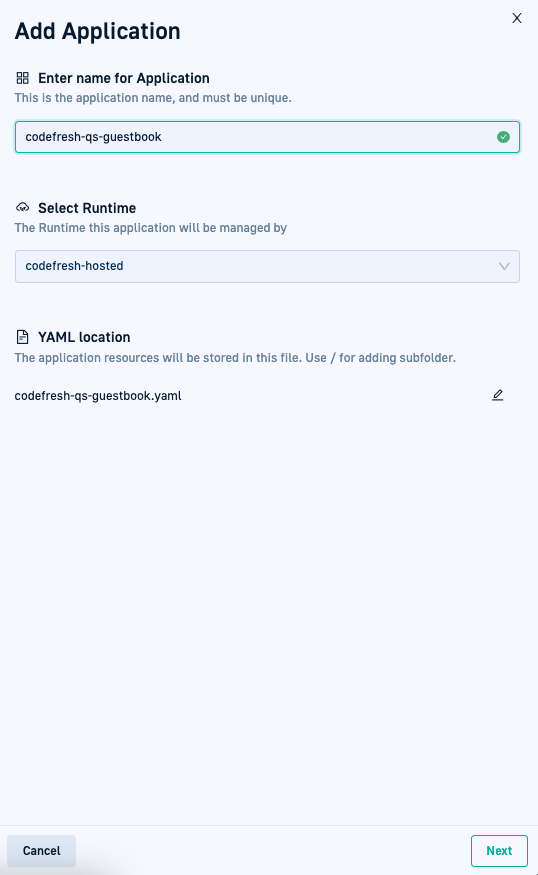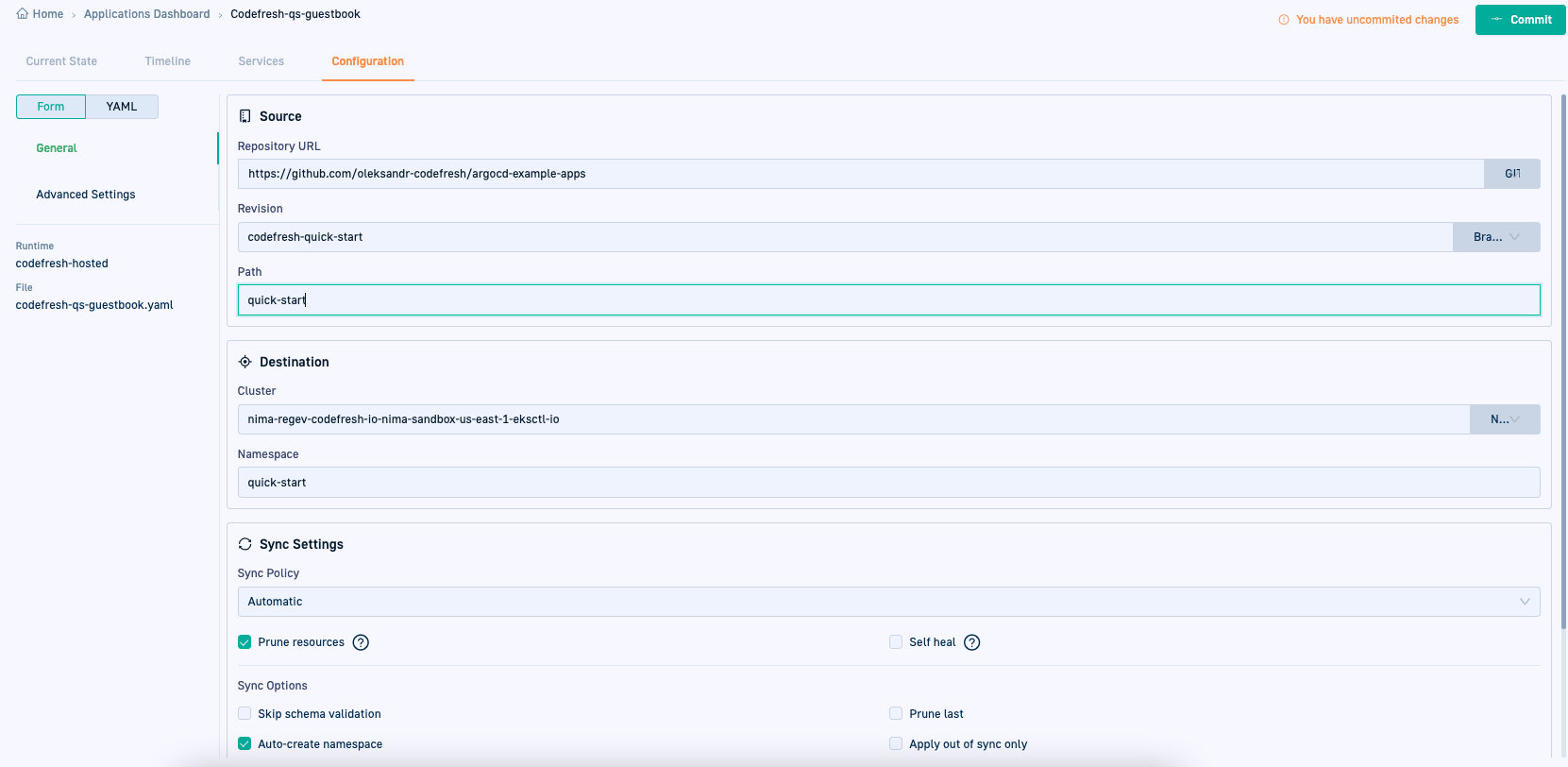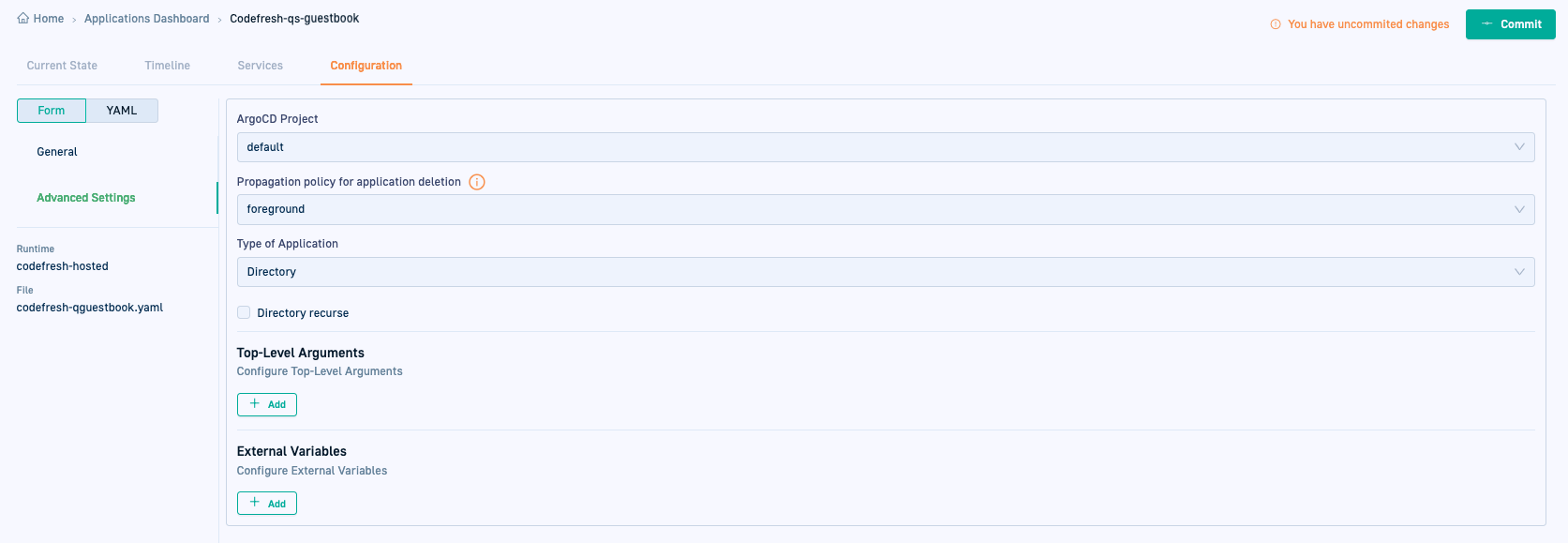Application configuration settings
Review configuration settings for Argo CD applications in Codefresh GitOps
Application configuration settings
Configuration settings for applications define the application’s structure, sources, destination, and operational behavior. For ease of use, settings are organized into distinct categories including:
- Application definitions: Basic metadata, such as the application name, GitOps Runtime, and the name of the YAML manifest.
- General configuration settings: Product, Group, source, destination, and sync policies for the application.
- Advanced configuration settings: Tool-specific options, project grouping, and propagation policies for resource and application deletion.
For how-to instructions, see Create applications.
Application: Definitions
Application definitions include the application name, the GitOps Runtime, and the name of the YAML manifest. By default, the YAML manifest has the same name as that of the application.
Application: General configuration settings
General configuration settings define the product, group, to which the application belongs, source, destination, and sync policies for the application.
Products
Optional. The product to which to assign the application. Select an existing product, or create and add a new product.
Products empower promotions for applications and make for streamlined management and deployments.
See Products.
Groups
Optional. The group or groups to which to add the application. Select an existing group or groups, or create a new application group by typing a name and pressing Enter.
Group applications based on criteria meaningful to your organization, such as environment, region, or any other relevant attribute. You can then view deployments for these applications in the same location in the Groups tab of the GitOps Apps dashboard. A new view for Argo CD applications, Groups allow you to collate multiple applications and view their timelines.
See Application Groups.
Source
The Git repository with the application resources.
- Repository URL: The URL of the Git repo or the Helm package repo with the application resources.
If SSH is configured for the Runtime, you can connect to the repo with SSH instead of HTTPS. On selecting the repository, Codefresh automatically updates the URL format. See Configure SSH for runtimes.
If the Argo CD project is not the default project, make sure that the repo has the correct access roles for your application.- Revision and Path: Applies to Git repositories.
- Chart and Version: Applies to Helm repositories. The name of the Helm package with all the resource definitions for the application.
The version is the version of the chart itself in the chart’sChart.yamlfile.
Destination
The cluster and namespace to which to deploy the application.
- Cluster: The cluster to which to deploy the application, defined as a URL, or as the user-defined display NAME.
- Namespace: The namespace in the cluster to which to deploy the application.
- Auto-create namespace: When selected, automatically creates the namespace in the cluster if it doesn't exist.
Sync Settings
Sync Policy
The synchronization policy to apply when there are differences between the desired state in Git and the actual state in the cluster.
- Manual: Manually sync the changes from the Argo CD UI.
- Automatic: Automatically sync changes, with the following options if selected:
- Prune resources:When selected, removes legacy resources that do not exist currently in Git.
- Self heal: When selected, always enforces a sync to the desired state in Git, if and when there is a change to the actual state in the cluster. See Automatic self-healing.
Sync Options
Common to both manual and automatic sync policies.
- Skip schema validation: When selected, bypasses validating the YAML schema.
- Auto-create namespace: When selected, automatically create the namespace if the specified namespace does not exist in the cluster.
- Prune last: When selected, removes those resources that do not exist in the currently deployed version during the final wave of the sync operation. See Prune last.
- Apply out of sync only: When selected, syncs only those resources in the application that have been changed and are OutOfSync, instead of syncing every resource regardless of their state. This option is useful to reduce load and save time when you have thousands of resources in an application. See Selective Sync.
Prune propagation policy
Defines how resources are pruned, applying Kubernetes cascading deletion prune policies. For more information, see Kubernetes - Cascading deletion.
- Foreground: The default prune propagation policy used by Argo CD. With this policy, Kubernetes changes the state of the owner resource to `deletion in progress`, until the controller deletes the dependent resources and finally the owner resource itself.
- Background: When selected, Kubernetes deletes the owner resource immediately, and then deletes the dependent resources in the background.
- Orphan: When selected, Kubernetes deletes the dependent resources that remain orphaned after the owner resource is deleted.
Replace: When selected, Argo CD executes kubectl replace or kubectl create, instead of the default kubectl apply to enforce the changes in Git. This action will potentially recreate resources and should be used with care. See Replace Resource Instead Of Applying Change.
Retry: When selected, retries a failed sync operation, based on the retry settings configured:
- Maximum number of sync retries (Limit)
- Duration of each retry attempt in seconds, minutes, or hours (Duration)
- Maximum duration permitted for each retry (Max Duration)
- Factor by which to multiply the Duration in the event of a failed retry (Factor). A factor of 2 for example, attempts the second retry in 2 X 2 seconds, where 2 seconds is the Duration.
Application: Advanced configuration settings
Advanced settings define the tool used to create the application, and related toll-specific settings.
ArgoCD Project
The project group to which the application belongs. A project is useful to enforce restrictions on permitted sources and targets for applications and roles. If not defined, the application is automatically assigned to the default project, which is created automatically by Argo CD and has no restrictions.
For more information, see Argo CD’s documentation on Projects.
Propagation policy for application deletion
Defines how resources are pruned, applying Kubernetes cascading deletion prune policies when you delete the application. For more information, see Argo CD’s app deletion.
- Foreground
The default prune propagation policy used by Argo CD. With this policy, Kubernetes changes the state of the owner resource to
deletion in progress, until the controller deletes the dependent resources and finally the owner resource itself. - Background When selected, Kubernetes deletes the owner resource immediately, and then deletes the dependent resources in the background.
- Non-cascading When selected, Kubernetes deletes only the application and not its resources.
Type of Application
The tool used to create the application’s manifests. Codefresh supports defining application manifests as a directory, Helm charts, or Kustomize. If you are using other tools to define application manifests, use the Plugin type. For more information, see the Argo CD’s documentation on Tools.
- Directory: A
directoryapplication, which is the default application type in Argo CD.- Directory recurse: Optional. Select to include subdirectories.
- Top-level arguments: Optional. Select and define parameters.
- External variables: Optional. Select and define external variables.
- Helm: Create the application as a Helm chart.
- Values files: One or more
values.yamlfiles to store the parameters. - Values: Optional. When defined, new values not in
values.yamlfiles are added, and existing values are overridden.
- Values files: One or more
- Kustomize: Create a Kustomize application, with the following settings:
- Version: The version of Kustomize used to create the application.
- Name Prefix and Name Suffix: Optional. The prefix and suffix to be appended to the resources of the application.
- Plugin: Use for any other tool.
- Name: The name of the Plugin used to create the application.
- External Variables: The variables to use in the application.
For example applications, go to the Argo CD example applications repo.
Related articles
Monitoring Argo CD applications
Managing Argo CD applications
Promotions
Manage products and applications in environments
Product Dashboard


